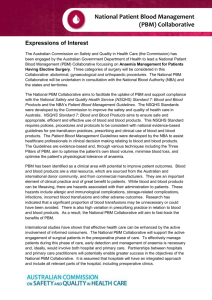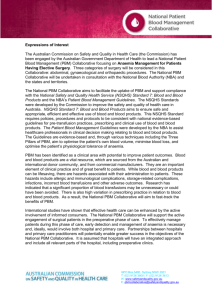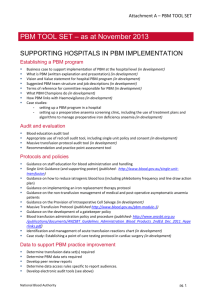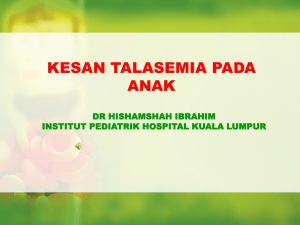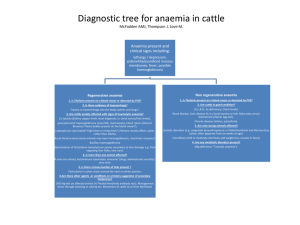EOI-PBM-Collaborative-Expression-of-Interest
advertisement
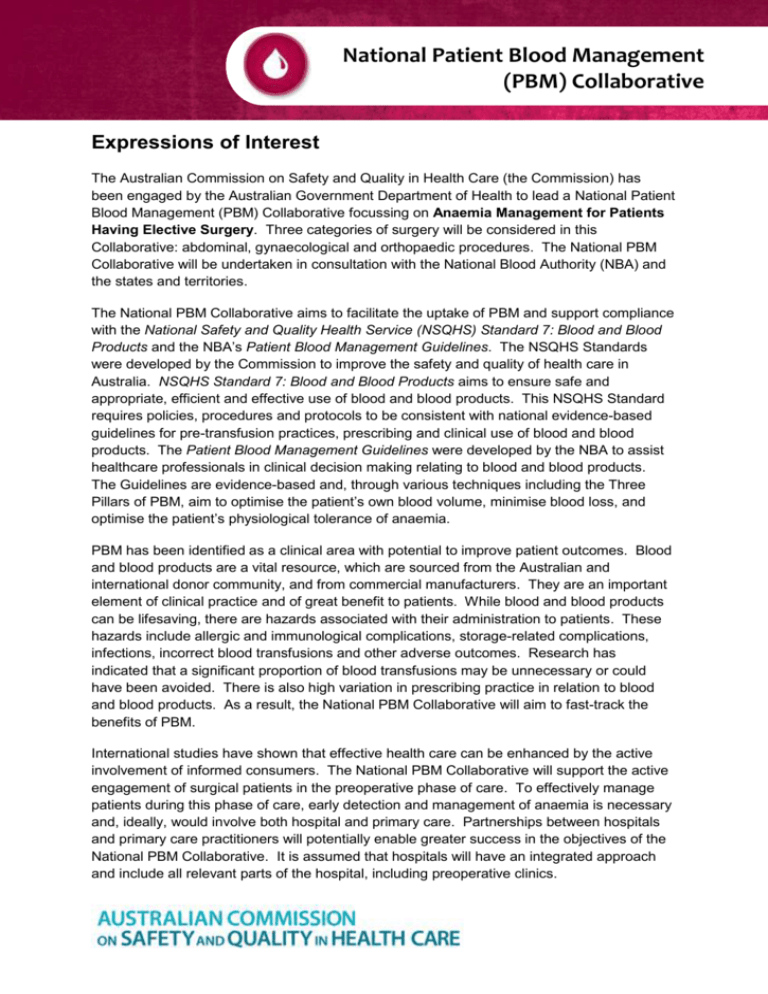
National Patient Blood Management (PBM) Collaborative Expressions of Interest The Australian Commission on Safety and Quality in Health Care (the Commission) has been engaged by the Australian Government Department of Health to lead a National Patient Blood Management (PBM) Collaborative focussing on Anaemia Management for Patients Having Elective Surgery. Three categories of surgery will be considered in this Collaborative: abdominal, gynaecological and orthopaedic procedures. The National PBM Collaborative will be undertaken in consultation with the National Blood Authority (NBA) and the states and territories. The National PBM Collaborative aims to facilitate the uptake of PBM and support compliance with the National Safety and Quality Health Service (NSQHS) Standard 7: Blood and Blood Products and the NBA’s Patient Blood Management Guidelines. The NSQHS Standards were developed by the Commission to improve the safety and quality of health care in Australia. NSQHS Standard 7: Blood and Blood Products aims to ensure safe and appropriate, efficient and effective use of blood and blood products. This NSQHS Standard requires policies, procedures and protocols to be consistent with national evidence-based guidelines for pre-transfusion practices, prescribing and clinical use of blood and blood products. The Patient Blood Management Guidelines were developed by the NBA to assist healthcare professionals in clinical decision making relating to blood and blood products. The Guidelines are evidence-based and, through various techniques including the Three Pillars of PBM, aim to optimise the patient’s own blood volume, minimise blood loss, and optimise the patient’s physiological tolerance of anaemia. PBM has been identified as a clinical area with potential to improve patient outcomes. Blood and blood products are a vital resource, which are sourced from the Australian and international donor community, and from commercial manufacturers. They are an important element of clinical practice and of great benefit to patients. While blood and blood products can be lifesaving, there are hazards associated with their administration to patients. These hazards include allergic and immunological complications, storage-related complications, infections, incorrect blood transfusions and other adverse outcomes. Research has indicated that a significant proportion of blood transfusions may be unnecessary or could have been avoided. There is also high variation in prescribing practice in relation to blood and blood products. As a result, the National PBM Collaborative will aim to fast-track the benefits of PBM. International studies have shown that effective health care can be enhanced by the active involvement of informed consumers. The National PBM Collaborative will support the active engagement of surgical patients in the preoperative phase of care. To effectively manage patients during this phase of care, early detection and management of anaemia is necessary and, ideally, would involve both hospital and primary care. Partnerships between hospitals and primary care practitioners will potentially enable greater success in the objectives of the National PBM Collaborative. It is assumed that hospitals will have an integrated approach and include all relevant parts of the hospital, including preoperative clinics. Expressions of Interest Process Expressions of Interest are being sought from public and private hospitals to participate in the National PBM Collaborative: Anaemia Management for Patients Having Elective Surgery. Three categories of surgery will be considered: abdominal, gynaecological and orthopaedic procedures. Health services may wish to include more than one category of surgery in their Expression of Interest; it will be important for health services to consider the volume of surgery so that clinical quality improvement can be achieved. To express interest in the National PBM Collaborative, please complete the registration form and submit by Friday 30 January 2015. The Commission will provide significant support to successful respondents to achieve the objectives set locally for improved patient care through PBM strategies. As general practitioners and primary health clinicians play a key role in the overall health management of these patients, Expressions of Interest that involve partnerships with primary care providers and organisations will be strongly supported. Joint projects that involve both public and private hospitals will also receive favourable consideration. State and territory departments of health have been consulted about the application process. When submitting applications to the Commission, public hospitals should ensure a copy is also provided to their state/territory contact as listed below: S/T ACT NSW NT Qld SA Tas Vic WA Contact A/Prof Deborah Browne Ms Sally Francis Mr Deane Wilks Ms Kirstine Sketcher-Baker SA Blood Management Council Ms Julie Tate Ms Glenda Gorrie Dr Audrey Koay Email deborah.a.brown@act.gov.au sally.francis@health.nsw.gov.au deane.wilks@nt.gov.au kirstine.sketcher-baker@health.qld.gov.au BloodOrganandTissuePrograms@health.sa.gov.au julie.tate@dhhs.tas.gov.au glenda.gorrie@health.vic.gov.au audrey.koay@health.wa.gov.au Please Note: The NSW Ministry of Health and the Clinical Excellence Commission have advised they would like the opportunity to provide advice on the selection of sites for participation from NSW hospitals. The South Australian (SA) Department of Health has proposed the Commission seek input from the SA Blood Management Council during the assessment process to assist in prioritisation of SA applications. Potential SA public sector applicants can seek advice during the development of their submissions from Council members via Barbara Parker or Christine Robinson on (08) 8463 6197 or BloodOrganandTissuePrograms@health.sa.gov.au The Commission, at its discretion, may discontinue this call for Expressions of Interest; decline to accept any offer; or, modify the number of participants in order to satisfy requirements and achieve overall project objectives. Enquiries For further information, please visit: www.safetyandquality.gov.au/national-priorities/pbm-collaborative/ E: pbmcollaborative@safetyandquality.gov.au P: (02) 9126 3648 National Patient Blood Management (PBM) Collaborative Frequently Asked Questions What is Patient Blood Management? Patient Blood Management (PBM) is a multidisciplinary approach that promotes appropriate care for patients. PBM also achieves reduced exposure to unnecessary blood or blood products, which is a beneficial safety and quality health care outcome. The objective of improving patient outcomes may be achieved through a number of means, including: optimising blood volume and red cell mass; minimising blood loss; and optimising a patient’s tolerance of anaemia. What is anaemia? Anaemia is a deficiency in the quality or number of red blood cells. There are three main classes of anaemia: excessive blood loss (haemorrhage), excessive blood cell destruction (haemolysis) and deficient red blood cell production (ineffective haematopoiesis). As red blood cells carry oxygen bound to haemoglobin around the body, anaemia can lead to a shortage of oxygen (hypoxia). A patient’s anaemia can be identified on the basis of a reduced haemoglobin level in circulating blood. Anaemia can commonly be caused by iron deficiency from blood loss or dietary deficiency, chronic diseases, medications or infection. The cause of anaemia is often identified by an examination of red blood cells or haemoglobin, and an assessment of its clinical features. Why is anaemia management important? A systematic review of evidence has found that preoperative anaemia is independently associated with an increased risk of morbidity and mortality. Preoperative anaemia has also been found to increase the likelihood of red blood cell transfusion, which has its own hazards. Anaemia management prior to elective surgery can improve a patient’s presurgery clinical status, and reduce post-surgery morbidity, mortality and length of stay in hospital. It is important to establish a definitive diagnosis of anaemia, whether it is related to the patient’s current condition, and if it is correctable. While some forms of anaemia cannot be prevented (if caused by a failure in the cell production process), other forms, such as anaemia caused by blood loss and dietary deficiency, can be prevented and managed. Unless there is a primary disorder of the marrow or some influence suppressing marrow function, most forms of anaemia are correctable without red blood cell transfusion within two or three weeks. If surgery is urgent, red blood cell transfusion may be necessary. However, anaemia may recur in the weeks following surgery. If red blood cell transfusion is used to correct anaemia in the short term, the cause of the anaemia will need to be followed up and/or the anaemia monitored to ensure it is resolved. What is a Collaborative? The Collaborative Model was developed by the Institute of Healthcare Improvement to achieve rapid and sustainable improvements in outcomes for patients in an identified topic area. It is a structure that enables organisations to learn from each other and from recognised experts in the identified topic area. A Collaborative is based on four components: identification of specific and measurable aims; measurement of improvements over time; identification of changes that facilitate the desired improvements; and a series of learning cycles where teams implement identified changes. Through Learning Workshops and Learning Cycles, health services share ideas for improvement, measure and benchmark outcomes and contribute to the future direction of best practice in the identified topic area. Working with experts, the National PBM Collaborative will support health service teams from across Australia. Over two years, teams will develop and trial strategies, new initiatives in clinical practice and organisation of services locally that promote PBM. Teams will come together to share knowledge on the actions, processes used to make change, and discuss outcomes and impacts on patients and their health service. How will the National PBM Collaborative help patients? By improving anaemia management for patients in the preoperative phase of care, the National PBM Collaborative may help to: reduce the risk of postoperative infections and adverse reactions from blood products reduce the risk of transfusion related inflammatory events reduce hospital length of stay reduce the risk of readmission from infectious complications of transfusion reduce elective surgery cancellations. How will the National PBM Collaborative help health services? Participating in the National PBM Collaborative will contribute to: strengthened compliance with NSQHS Standard 7: Blood and Blood Products implementation of NBA’s Patient Blood Management Guidelines continuous quality improvement in the work of the health service enhanced data collection to support service improvement, accreditation and compliance informing the development of local strategies to strengthen the elective surgery referral and treatment pathway the development of local leaders, and enhanced clinical engagement to support quality improvement in the health service. What is the structure of the National PBM Collaborative? The National PBM Collaborative is expected to commence in March 2015 and continue until April 2017. An orientation will formally commence the Collaborative and explain key concepts and requirements for participation. There will be up to six Learning Workshops throughout the Collaborative. After each Learning Workshop, Action Periods are held, during which teams test ideas for improvement using the model for improvement (Plan, Do, Study, Act Cycles – PDSAs). By testing ideas, monitoring activity and reporting on progress against targeted aims teams will be able to determine which ideas are successful and if they could lead to broader sustainable information. This information will feed into the next Learning cycle. The workshops will allow teams to share their experiences of local quality improvement processes; learn from colleagues; consult with experts in the field; gather new information; and develop ideas for improvement. During Action Periods, teams will work towards implementing ideas within their health service, while maintaining contact with each other to share progress and improvements, monitor activity and report against targeted aims on a monthly basis. What support and resources will be provided? The Commission will provide the following to participating teams: Orientation and Learning Workshops Travel and accommodation, for up to three key staff, to attend the orientation and Learning Workshops PBM education, training and tools, including: web interface for communication and transfer of data analytical support and generation of performance reports PBM forums for ongoing discussions and communication expert support, available both on-site and through web applications In addition, a package of resources to meet the individual needs of each team will be developed, which may include funding to support the appointment of project staff or employee backfill to attend the Collaborative activities. What is required of the project team and health service? The health service is the provider, or part of a service network, which undertakes elective surgery. Demonstrated institutional support for participation in the Collaborative, with Chief Executive Officer sign-off. Demonstrated commitment to project governance through a new or existing committee, which includes participation by nominated senior executive staff. Nominated key staff must include a senior clinical lead, clinician and project officer. The health service should also commit local necessary resources to support the conduct of the Collaborative and enable: o nominated key staff to attend the orientation and Learning Workshops o key staff to dedicate time to work on PBM during Learning Cycles o submission of appropriate reports and data against targeted aims during each Action Period. The health service should determine and organise approvals that may be required in regards to ethics and other matters. Health services will need to consider the volume of surgery so clinical quality improvement can be achieved. Health services should indicate a minimum threshold for each of the categories of surgery they will be including for the Collaborative.
